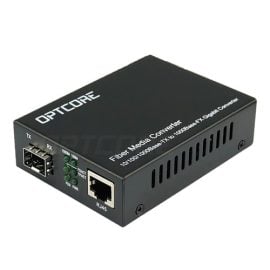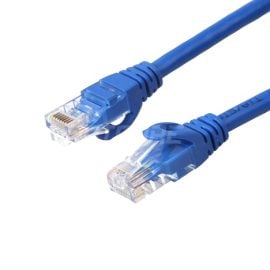Blog, Networking Device
What Is a PoE Camera: A Beginner’s Guide
Consider connecting a single cable and having the razor-sharp 4K surveillance switched on right away, with no dead Wi-Fi areas, offering crystal-clear security that never blinks.
That is the possibility of PoE cameras, which is changing how you secure the most important things in your life.
This brief guide simplifies what you need to know so that you feel comfortable making the choice that addresses your needs when getting the best PoE camera.
What Is a PoE Camera?
A power over Ethernet (PoE) camera is an IP surveillance device that supplies electrical power, and the same Cat5e/Cat6 cable transmits video data. It does everything in one line, cuts the installation time and expense, and makes the wiring neat. The solution is based on IEEE 802.3 standards with the latest 90-watt limit (suitable for 4K sensors and PTZ motors).
How Does a PoE Camera Work?
There are three components of a PoE camera system:
- Power-sourcing equipment (PSE): either a PoE switch or an injector.
- The camera as an entity (PD) haggles in class, consuming only the required watts.
- Recorder or video server: records and plays back video on the same LAN.
How PoE Works: the switch sends a handshake, detects resistance to determine the power level, supplies the camera DC, and returns the H.265 packet stream up to 100 m (328 ft). Cameras never stop filming with a UPS on the switch—something the AC-powered Wi-Fi versions simply cannot guarantee.
Market Pulse: Researchers estimate the global security camera sector will grow to USD 18.3 billion in 2025, generating a stable 9.2 % CAGR by 2034, mainly powered by PoE-ready AI cameras for smart cities.
Types of PoE Cameras
PoE is nothing more than a delivery technique, and thus, all conventional form factors exist in a PoE version:
| Type | Best Use | Why Pick It |
| Bullet | Perimeters, parking lots | Large lenses, good IR, and long housing keep away vandals. |
| Dome | Retail ceilings, lobbies | A vandal-proof dome conceals direction. |
| Turret (Eyeball) | Soffits, hallways | No glass dome glare; flexible aiming. |
| PTZ | Warehouses, stadiums | 360 Optical zoom and auto-following. |
| Fisheye/360° | Classrooms, open halls | One lens covers the whole room and de-warps in software. |
Bullet cameras can be used outside because they have long, weatherproof housings and robust infrared on driveways or fences. The direction of the lens on a dome camera is concealed in a vandal-resistant bubble, a nice application on the ceilings of large retail stores or lobbies. Turret (eyeball) models combine a compact dome-like shape and the absence of glare on the glass, which is ideal for soffits and corridors.
A PTZ ( pan-tilt-zoom ) unit can cover 360 degrees of zoom in tight areas and the area where multiple fixed views are needed. Fisheye/360 cameras can be mounted on a ceiling to provide a view of an entire room and de-distort the viewing with software. The right combination will make your PoE system attain a compromise between deterrence, detail, and budget.
Key Features for the best PoE Camera
- Resolution & Sensor: 4K is the new norm, but a large sensor (1/1.8) is best to handle at night.
- Wide Dynamic Range: 120 dB. 1st DataImage provides 120 dB true WDR, eliminating cracked entrances.
- Night vision: 850 nm IR and F1.6 or starlight technology sub-0.005 lux in color.
- AI Analytics: Human/vehicle filtering reduces false alerts by as much as 86%.
- Smart H.265+ releases half the cost of storage in busy scenes.
- Rating: Weather rating (outdoor): IP66 minimum, IK10.
- Storage options: Micro SD backup and ONVIF are compatible with different brands.
- Power Budget: Verify the wattage of switches for Class 4 (30 W) heaters and Class 5/bt (60 W to 90 W) large PTZs.
- Cybersecurity: Select vendors that sign firmware and update frequently on CVE.
Advanced PoE Technologies You Should Know
PoE is not all alike. The traditional 802.3af specification provides a maximum of 15.4 W per 1080p fixed lens; 802.3at (PoE++) can deliver 30 W and allows 4K domes with heaters. The AC-powered latest 802.3bt PoE+++) transports 60–90 W over four pairs and has been available in the largest switches since the middle of 2024. Such headroom allows you to drive high-speed PTZs and edge AI processors.
PoE++ adoption today is a form of feature creep insurance. By 2026, analysts project that 38 % of new professional cameras will have onboard deep-learning processors, compared to 11 % in 2023. (gminsights.com)
Cost Considerations
Since you are not using separate power wiring, a PoE deployment would save between $30 and $50 in installation costs per camera drop. On average, in the surveys that CCTV Camera World conducted nationwide early in 2025, with a pool of 5,000 installers. Considering the reduction in maintenance, none of the wall-wart adapters break, and PoE can even pay for itself in the first year.
Recommended products
-
10/100/1000Base-T RJ45 to 1000Base-FX SFP Fiber PoE Media Converter
US$ 19.90 (Excl. VAT) -
10/100/1000Base-T RJ45 to 1000Base-LX SC 1310nm 10km Fiber PoE+ Media Converter
US$ 31.00 (Excl. VAT) -
Cat6 Ethernet Network Patch Cable, Snagless Unshielded (UTP), PVC, Blue
Price range: US$ 0.85 through US$ 13.10 (Excl. VAT)
FAQs About PoE Cameras
Q1. What is a PoE security camera?
PoE security cameras provide more reliable streams, and it is simpler to back up centrally when using one Ethernet connection to handle power and data flow. These cameras are much more reliable than Wi-Fi cameras.
Q2. What is a PoE camera system?
It is a package of several PoE cameras with a PoE switch or NVR that supplies power to all units and records them when the cable is connected.
Q3. Are PoE cameras Internet-free?
Yes. Live view and recording proceed as long as power is supplied to the local network and the recorder.
Q4. What is the range of Ethernet security cameras?
Unmodified Cat6 has limits of 100 m; extension of PoE or fiber should cover more than 300 m.
Conclusion
PoE cameras combine neat cabling with business-level reliability, and they are a great investment when you want to make surveillance and monitoring truly 24/7. Adhere to the steps in the above checklist, and you will deploy a forward-looking PoE system that will keep watch in the future.
In the future, edge analytics and 8K sensors will require even greater bandwidth consistency and power stability. Of course, these benefits are encoded in the PoE standard. With the future of communications being in digital transmission, by investing in the proper cabling today, you are securing your money and leaving the possibility of system upgrades as wide open as possible.
Read More:
- PPPoE vs DHCP: What are the Differences, How to choose?
- PoE vs PoE+ vs PoE++ vs UPoE vs UPoE+: What is the difference?
- What Is PoE Switch: A Complete Guide










